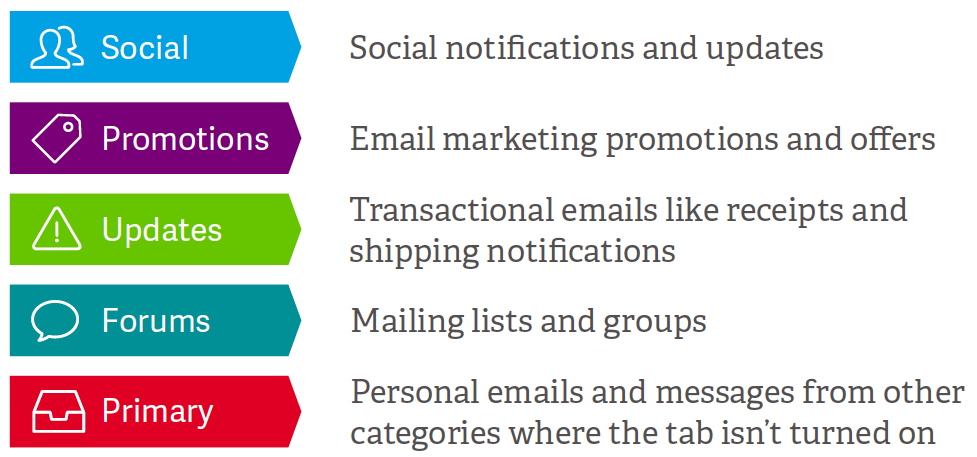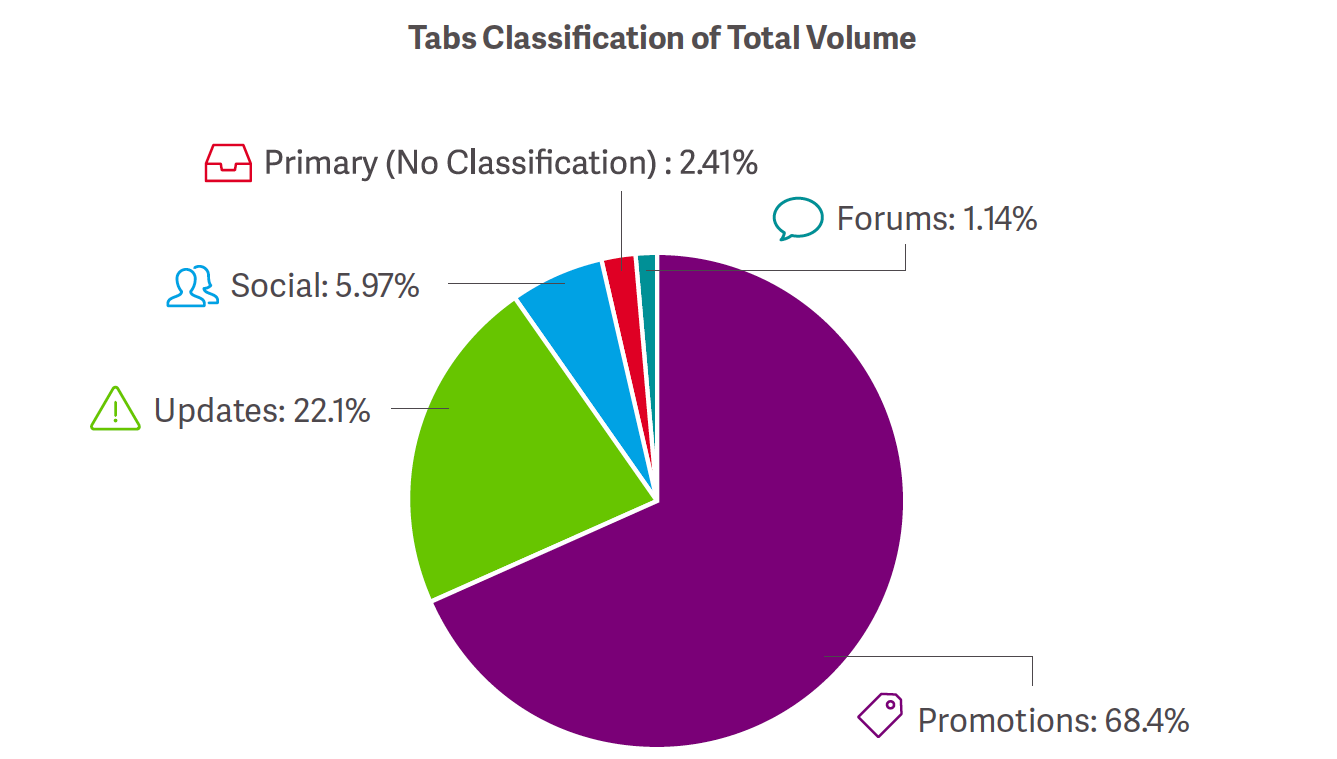A Marketer’s Email Deliverability Guide for Gmail Tabs

Reading Time: 7 minutes
Introduction
Gmail introduced its current tabbed inbox layout in May 2013. Since then, marketers have debated the usefulness of this feature. Some have argued it means death for email marketing, while some others claimed it lets the end-user seek out specific Promotional emails when they want them. Another group of marketers constantly tries to land their Promotional emails in the Primary tab meant for personal communication, as a way to improve open rates for their email marketing campaigns.
| Bonus Content
👉 The Modern Marketer’s Quick Guide to Email Marketing 👉 FabHotels Achieve 90% Improvement in Email Deliverability 👉 20X in Email Open Rates Helps EarlySalary Reduce Drop-off Rate by 5% |
Although the debates rage on, a recent survey conducted by Return Path sheds some light on the questions in the minds of today’s email marketers regarding the impact of these tabs. We’re going to look at that research below, but before we dive deeper, let’s review the various Gmail tabs and their purposes.

With this categorization, Gmail aimed to help its 1.2 billion users organize the clutter of emails in their inboxes and focus on each kind of conversation separately. However, for the marketer, this approach often results in carefully crafted emails getting lost in the deluge of promotional emails their users receive.
This fear is reasonable since—as indicated by the chart below, more than 68% of email received by a user is Promotional.

What’s worse is the fact that the emails under the Promotions tab seem to have the lowest overall read rate.

It is clear marketers face an uphill task when it comes to getting their audience to engage with their emails in Gmail if they can only land in the Promotions tab. However, there’s some good news.
From the ReturnPath survey, we’ve learned users check their Promotions tab a lot more often than previously thought.

As you can see, 26.5% of survey respondents said that they check the Promotions tab at least once a day. This suggests that a significant section of your target audience will still see your email even if it is placed in the Promotions tab. On the other hand, the average user might never look beyond their Primary tab, driving marketers to try and get their emails to land in that tab instead.
In either case, the marketer faces a challenge. To succeed, marketers must find the right balance between the content and its placement inside the Gmail inbox. This can be achieved in two ways:
- Improve open rates for the Promotions tab
- Adjust promotional campaigns so they land in the Primary tab
Let’s look at each of these two options carefully to understand them better.
Improving Email Open Rates on the Promotions Tab
Like we mentioned earlier, all is not lost if your emails land in the Promotions tab. When we consider the numbers, we see a close to 20% read rate in a category were close to 70% of emails land. Also, remember that this tab is opened at least once daily by almost half of all Gmail users, and suddenly it seems to be a pretty good place for your promotional email to wind up.
Benefits of winding up in the Promotions tab
- Focus: Being classified as a Promotional email means your users have an easy path to your message if and when they are ready to shop.
- Fewer spam reports and unsubscribes: Since the promotional emails do not clutter the main inbox, they are less likely to prompt an unsubscribe request or get marked as spam which, in turn, keeps their sending reputation intact.
- Healthier open rates: This might seem unlikely, but since half the users check their promotions tab at least once every day, highly engaged users now have an even easier path to your email whenever they need it.
Good Email Practices to follow
To get the most out of your emails placed in the Promotions tab, you need to make sure they stand out. This can be achieved if you follow the good email practices outlined below:
a) Send the right kind of content
When your users subscribe to your website, give them a clear idea of what kind of emails they can expect from you (offers, promotions, newsletters, information, etc.) so there is a higher chance of users expecting and opening your emails regularly.
b) Use personalization
Emails personalized with the recipient’s first name and other personal information in the subject line as well as the body have a significantly better open rate compared to generic emails.
c) Segment users
Sending targeted emails to users after thorough segmentation results in users receiving relevant emails, tailored to their behavior. This improves the chance that they’ll engage with those emails.
d) Use organic lists
Mailing lists acquired through inorganic methods always result in low open rates since the recipients never signed up for your emails in the first place. Also, with privacy rules such as GDPR getting more stringent by the day, such actions can land you in a lot of trouble.
e) Stick to the right frequency
Receiving too many emails can put off any recipient, and prompt a spam complaint. Try to use a preference center that lets users set the frequency of the emails they’ll receive from you.
f) Put quality above quantity
Stay focused on the quality of your communication with your audience, not the quantity. This will foster trust and help build lasting relationships with your audience. So, don’t forget to check that your emails have good deliverability with the DMARC report.
g) Have a clear unsubscribe link
Respect the choice of your user regarding whether they want to continue receiving emails from you or not.
It’s better to let a user go than to annoy them to a point where they mark your email as spam since that adversely impacts your sender reputation and deliverability.
| Bonus Content |
Note: To learn more about maximizing results for your email program, check out our post on email sending best practices.
Landing Emails in The Primary Tab
The tips above will help you maximize your results if your message ends up in the Promotions tab. But you can also take steps to get your email in the Primary tab instead. Gmail defines the Primary tab as a place where users keep emails from people they know. The two key words in this definition are “people” and “know.”
If you want your email to land in the Primary tab, you need to make it look like it has been sent by a person, and that the recipient knows the sender. Here are a few ways you can achieve this.
1. No HTML
Most emails that land in the Primary tab is sent from real people (like friends and co-workers) and probably don’t include fancy HTML. Instead, they are largely text-based with basic formatting and perhaps a few links and an image. This is the high-level benchmark that Gmail uses when evaluating whether an incoming email qualifies for the Primary tab or not. To get your email in the Primary tab, strip out all the fancy designs and stick to the basic content delivered in the simplest manner possible.
2. Use real names and email addresses
Blatantly promotional email addresses like [email protected] are easily classified as Promotional and will be placed in the Promotions tab. Using real sender names instead, as John Doe [email protected], suggests the sender might be a real person and the content might not be promotional.
3. Avoid images
Images are an integral part of promotional emails, showing up in the header, body, and footer. As a result, emails with a lot of images typically get classified as Promotional. Reducing the number of images increases your chances of landing in the Primary tab.
4. Reduce links
Like images, links are an integral part of a Promotional email and are a determining factor when deciding whether an incoming email is promotional. When trying to get your emails in the Primary tab, use only the links most critical to your campaign.
5. Get authenticated
Another important set of factors is whether the sender is acknowledged by the recipient as a legitimate sender and whether the sending domain is verified to be genuine. Emails sent by unverified domains are likely to land directly in the spam folder. In addition, emails sent from addresses that are not in the recipient’s address book are less likely to be placed under the Primary tab. To avoid either of these scenarios, get your SPF, DMARC reports, and DKIM authentications in order. Most good email marketing platforms do this as standard practice when you sign up with them. Also, encourage your subscribers to add your email address to their address book.
Conclusion
Gmail uses sophisticated AI and Machine Learning technologies to decide which email belongs in which tab. These algorithms decide on tab selection based on a combination of Gateway and Delivery Agent information. On the Gateway side, they look at the sender’s global reputation, list quality, engagement, etc., and on the Delivery Agent (Inbox) end, they measure factors like engagement before deciding where to place an email. Therefore, marketers need to keep the various factors listed above in mind and design their email programs accordingly.
However, also keep in mind that users who take their Primary tabs seriously may not like promotional content sneaking in there, and they might decide to punish the sender by unsubscribing or flagging an email as spam—which can negatively impact a marketer’s deliverability.
But that’s why you have two options, right? You can strive to improve your open rates in the Promotions tab or you can try to get your emails in the Primary tab. Better yet, try both ways and see which one yields better results.
Would you like to explore MoEngage Email?
Image Source: Return Path Blog.










